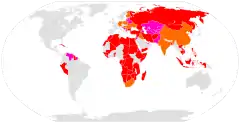Zastava M70
The Zastava M70 (Serbian Cyrillic: Застава М70) is a rifle developed and produced by Zastava Arms in Serbia (formerly Yugoslavia). The design of the M70 was based on the Soviet AKM rifle and it became the standard issue weapon in the Yugoslav People's Army in 1970. This weapon is also available as the ZPAPM70 (1.0 stamped receiver), ZPAPM70 Classic (1.5mm stamped receiver with bulged RPK style front trunnion, chrome lined bore), O-PAP (1.5mm stamped receiver with bulged RPK style front trunnion) or N-PAP (1.0mm stamped receiver, standard AKM style front trunnion) in the United States without select fire capabilities.
| Zastava M70 | |
|---|---|
 A Zastava M70AB2 | |
| Type | Assault rifle |
| Place of origin | Yugoslavia |
| Service history | |
| In service | 1970–present |
| Used by | See Users |
| Wars | Rhodesian Bush War Persian Gulf War Lebanese Civil War Yugoslav Wars Rwandan Civil War First Congo War Kosovo War Insurgency in the Republic of Macedonia Liberian Civil Wars War in Afghanistan Iraq War Kivu conflict Libyan Civil War Syrian Civil War Northern Mali conflict Iraqi Civil War[1] |
| Production history | |
| Designer | Zastava Arms |
| Designed | 1959–1968 |
| Manufacturer | Zastava Arms |
| Produced | 1970–present |
| No. built | 4,000,000[2] |
| Variants | See Variants |
| Specifications | |
| Mass | 3.70 kg (8.2 lb) |
| Length | 940 mm (37 in) |
| Barrel length | 415 mm (16.3 in) |
| Cartridge | 7.62×39mm |
| Action | Gas-operated (rotating bolt) |
| Rate of fire | 620 rounds/min |
| Muzzle velocity | 720 m/s (2,400 ft/s) |
| Effective firing range | 410 m (450 yd) |
| Feed system | 30-round AK-47 detachable box magazine, 40-round RPK magazine, 75-round RPK drum magazine |
| Sights | Iron sights |
History
_3.jpg.webp)
Development of the domestic Kalashnikov variant began in 1959, and the first models submitted by Zastava for military field trials were with the early M64 (or M59) series of rifles with milled receivers, threaded barrels, familiar Zastava handguards, gas cutoffs for grenade launching, and several other diversities from the mainstay AK design, such as a bolt hold open device on the right side of the receiver, and a charging handle that appeared different from other AK models. Though performances were satisfactory, the Yugoslav military did not adopt the rifle as the standard infantry armament.[3]

In 1970, the green light was given to begin with army-funded mass production of the AP M70 and M70 A series (Automatska Puška Model 1970, "Automatic Rifle Model 1970") of which the M70 A was the folding stock version.[4] It became the standard issue weapon in the Yugoslav People's Army in 1970.[5]
Before the larger models of these rifles were made, cost-cutting measures in production resulted in the removal of the internal bolt hold open, and relocation to the magazine follower. This change eliminated any possible speed up in the reloading procedure (due to the bolt closing upon removal of the magazine) but allowed the operator to more easily identify if the current magazine is empty. Some rifles were also equipped with a notched selector control which allowed you to lock the bolt rearward by closing the dust cover on the charging handle. In addition, the usual placement of the barrel through threading into the receiver was replaced by the cheaper method of pressing and pinning the barrel into the receiver.[4] Rifles produced with these new features were known as models AP M70 B (fixed stock version), and M70 AB (folding stock version).[4] As with the M70 series of automatic rifles, these models failed to be produced in larger quantities before further cost-efficiency production measures gave way to yet another model.
This time the milled receiver was replaced by a receiver stamped from a smooth 0.9 mm (0.04 in) thick sheet of steel, a firing rate reducer was added to the trigger group, and the muzzle brake replaced the muzzle nut that originally came on the two prior models; the produced models were AP M70B1 (fixed stock) and M70 AB1 (folding stock).[4]
These models eventually failed to mass-produce as well, before final alterations to the M70 rifle design resulted in the AP M70 B2 (fixed stock) and M70AB2 (folding stock) models. These last two models featured a thicker 1.5 mm (0.06 in) stamped receiver and bulged front trunnion, which was intended to strengthen the rifle in order to make it more suitable for frequent grenade launching.[4] These two models would become the most widely produced of the M70 series, and in turn, the most widely used model used by the JNA,[4] as well as the other militaries and various armed groups fighting in the Yugoslav wars of the 1990s. Parts kits imported into the U.S. however, show markings that appear to contradict the final fixed stock model name. On these kits, the bulged, thicker stamped receiver model is actually the M70B1 model.
All of the M70 models share the grenade launching ability with gas cutoff, the lengthened wooden handguard with 3 cooling slots, iron sights with flip-up illuminating elements, initially filled with phosphorus and later with tritium (Which is used on the current production M70's), to improve aiming at night; the plunger that keeps the receiver cover in place during grenade launching, and a non-chrome lined barrel. Fire selectors have R markings for automatic fire (R for rafalna, "burst fire") and J for semi-automatic fire (J for jedinačna, "single"). In the US market, the notched safety lever and bolt hold open magazines have been emulated by many companies as aftermarket accessories for other AKs. There also has been at least one attempt to recreate the original internal bolt stop.[6]
The M70 and all of its variations were well accepted by the professional soldiers and conscripts of the Yugoslav People's Army. It was nicknamed "Ciganka" and "Srpkinja" meaning Gypsy and Serbian Girl respectively, due to dark finish on its metallic parts.[7]
Design and features
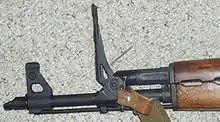
The M70 is designed on the basis of Kalashnikov principle;[8] however, it can easily be told apart from other AK rifles by the three cooling slots on the foregrip, the light-coloured elm wood furniture and, both, the black rubber buttplate and lack of receiver tangs on fixed-stock M70s. The M70s also have a grenade-launching sight and gas cut-off on the gas block, and are capable of launching rifle-grenades. To launch them a 22 mm diameter grenade launching adapter is screwed on in place of the slant brake or other muzzle device.
The receiver of the M70 is 1.5 mm thick, compared to the 1 mm thick receiver of the AKM, making it more rigid. The receiver has a bulge at the front to accommodate an enlarged trunnion similar to a RPK receiver, with the front trunnion rivet configuration likewise resembling a RPK and not an AKM. Much like the other AKs, the M70 experienced changes to other parts between the milled and stamped variants, such as moving the gas relief ports from the tube to the gas block, adding lightening cuts on the bolt and bolt carrier, moving the rear sling swivel from the back of the receiver to the buttstock and omission of the metal ferrules from the lower handguards and pistol grips. It however, like the Type 56, retained many milled features, such as the thicker barrel, front sight shape, bolt and bolt carrier "in the white", smooth dust cover, lack of a pistol grip reinforcement plate on underfolders, forward sling loop on the gas block and blued finish. Intriguingly, the M70 always used the AKM style bayonets with lug under the gas block even on milled versions. Likewise, the barrel is hammer forged and was never chrome-lined, making it a little more accurate than a standard AKM, but at the cost of increased susceptibility to corrosion and shorter barrel life. The lack of chrome lining is unique for an AK and consistent with other Zastava built rifles of Soviet design (such as the Yugoslavian M59 or M59/66). The fixed stock versions have a unique rear trunnion and stock attachment method, with the two rivets in a vertical strait line and a large bolt passing through the majority of the stock and connecting it to the rear trunnion. Like the East German MPi-KM, the fixed stocks also lacked a storage compartment for the cleaning kit. It also has flip up tritium night sights like the RK 62 and IMI Galil. Unlike other AK variants, a lock button must be depressed on the left side of the receiver as the first step for field stripping, to enable depressing the rear spring guide to remove the receiver dust cover. It is probable this feature is intended to prevent the loss of the top cover due to recoil when firing rifle grenades.
Variants


- M70 – milled receiver, fixed stock
- M70A – milled receiver, underfolding stock
- M70A1 – milled receiver, underfolding stock, mount for night or optical sights
- M70B1 – stamped receiver, fixed stock
- M70AB2 – stamped receiver, underfolding stock
- M70B1N – stamped receiver, fixed stock, mount for night or optical sights
- M70AB2N – stamped receiver, underfolding stock, mount for night or optical sights
- M70AB3 – stamped receiver, underfolding stock, rifle grenade sight removed and replaced with a BGP 40 mm underslung grenade launcher
- M70B3 – stamped receiver, fixed stock, rifle grenade sight removed and replaced with a BGP 40 mm underslung grenade launcher
- M92 – carbine, the shorter variant of the M70AB2
- PAP M70 – semi-automatic variant intended for the civilian market
- Tabuk - Iraqi copy. Bore and chamber are not chrome plated.[9]
- Tabuk Sniper Rifle – Iraqi long barrel stamped receiver and fixed stock variant
Users
 Afghanistan[10][11]
Afghanistan[10][11] Angola[12]
Angola[12] Bosnia and Herzegovina[13]
Bosnia and Herzegovina[13]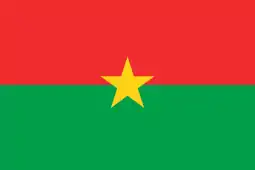 Burkina Faso: used by the Burkinabese contingent of the United Nations Multidimensional Integrated Stabilization Mission in Mali[14]
Burkina Faso: used by the Burkinabese contingent of the United Nations Multidimensional Integrated Stabilization Mission in Mali[14]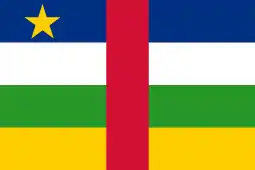 Central African Republic[15]
Central African Republic[15] Democratic Republic of Congo: used by rebel groups, such as CNDP and FDLR[16]
Democratic Republic of Congo: used by rebel groups, such as CNDP and FDLR[16] Croatia[17]
Croatia[17]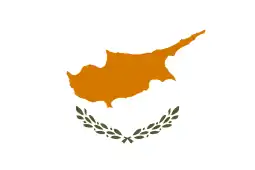 Cyprus[18]
Cyprus[18] Iraq[9][19][1]
Iraq[9][19][1] Jordan[19]
Jordan[19] Lebanon[19]
Lebanon[19] Liberia[20]
Liberia[20]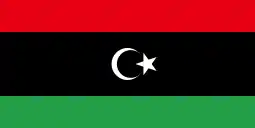 Libya[21]
Libya[21]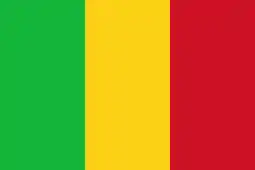 Mali: 1,000 rifles donated by Croatia in 2013[22]
Mali: 1,000 rifles donated by Croatia in 2013[22] Montenegro
Montenegro North Macedonia[23]
North Macedonia[23]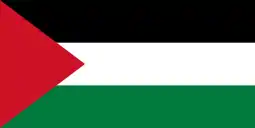 Palestine
Palestine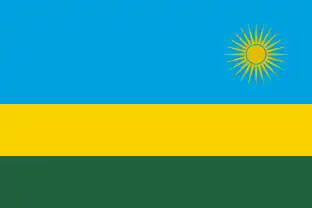 Rwanda[16]
Rwanda[16] Serbia[24]
Serbia[24] Slovenia[25] Used by reserve soldiers.
Slovenia[25] Used by reserve soldiers. Somalia[26]
Somalia[26]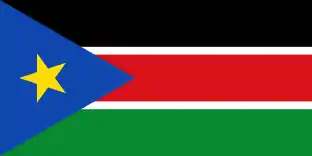 South Sudan[27]
South Sudan[27] Yemen[27]
Yemen[27]
Former users
 Kosovo Liberation Army
Kosovo Liberation Army.svg.png.webp) Yugoslavia
Yugoslavia Zaire: used by mercenaries in 1997[28]
Zaire: used by mercenaries in 1997[28]
See also
References
- Iraq: Turning a blind eye: The arming of the Popular Mobilization Units (PDF) (Report). Amnesty International. January 5, 2017. p. 26. MDE 14/5386/2017. Archived (PDF) from the original on March 13, 2017. Retrieved October 26, 2018.
- "M70". Weapon Systems Net. Archived from the original on September 18, 2014. Retrieved November 16, 2014.
- Nurkić 2005, p. 71.
- Nurkić 2005, p. 72.
- "History of Zastava Arms 1945–1970". Zastava Arms. 2008. Archived from the original on May 7, 2012. Retrieved November 16, 2014.
- "The TRUE bolt stop for your AK47!". February 19, 2009. Archived from the original on February 19, 2009.
- http://www.balkanwarhistory.com/2016/06/zastava-m-70-or-gypsy.html%5B%5D
- "Assault Rifle M70 AB2 | Zastava-arms". Zastava Arms. Zastava. Archived from the original on April 29, 2015. Retrieved December 7, 2017.
- Rottman 2011, p. 49.
- https://www.youtube.com/watch?v=UwbcQpbblJU
- https://web.archive.org/web/20120512130653/http://www.dvidshub.net%3A80/image/574119/marines-perspective-progress-helmand-province
- "Zastava oružje najavila povratak na tržište Angole i Egipta" [Zastava Arms announces return to the market of Angola and Egypt]. eKapija (in Bosnian). Archived from the original on February 1, 2016. Retrieved January 26, 2016.
- "Bosnia Herzegovina Land Forces military equipment, armament and vehicles Army". Armyrecognition.com. Archived from the original on September 25, 2018. Retrieved March 18, 2018.
- Cherisey, Erwan de (July 2019). "El batallón de infantería "Badenya" de Burkina Faso en Mali - Noticias Defensa En abierto". Revista Defensa (in Spanish) (495–496).
- Berman, Eric G.; Lombard, Louisa N. (December 2008). The Central African Republic and Small Arms: A Regional Tinderbox (PDF). Small Arms Survey. pp. 82, 94. ISBN 978-2-8288-0103-8. Archived (PDF) from the original on January 7, 2017. Retrieved September 15, 2018.
- Small Arms Survey (2015). "Waning Cohesion: The Rise and Fall of the FDLR–FOCA" (PDF). Small Arms Survey 2015: weapons and the world (PDF). Cambridge University Press. p. 201. Archived (PDF) from the original on January 28, 2018. Retrieved August 29, 2018.
- Army, MSG Rich Kem, U. S. (February 10, 2013). "English: Soldiers from the Minnesota Army National Guard train with members of the Croatian army in Croatia during Guardex 12". Archived from the original on May 10, 2015. Retrieved March 18, 2018 – via Wikimedia Commons.
- "Kipar prodaje Maliju Zastavine kalašnjikove" [Cyprus selling Mali Zastava Kalashnikovs]. Kurir (in Bosnian). February 1, 2013. Archived from the original on January 31, 2016. Retrieved January 26, 2016.
Kiparsko Ministarstvo odbrane ponudilo je 2.364 automatskih pušaka koje je proizvela kragujevačka "Zastava", afričkim snagama koje pomažu vlastima u Maliju u borbi protiv islamskih ekstremista. ("The Cypriot Ministry of Defence has offered 2,364 automatic rifles produced by the Kragujevac-based "Zastava", to the African forces to help the authorities in Mali to fight Islamic extremists.")
- Republic of Serbia: Ministry of Economy and of Regional Development. Annual Report on the Transfers of Controlled Goods in 2008. p. 37. Archived from the original on December 21, 2014. Retrieved October 25, 2014 – via Stockholm International Peace Research Institute.
- Small Arms Survey (2009). "Revealing Provenance: Weapons Tracing during and after Conflict" (PDF). Small Arms Survey 2009: Shadows of War. Cambridge University Press. pp. 108, 110. ISBN 978-0-521-88041-1. Archived from the original on August 30, 2018. Retrieved September 7, 2018.
- Jenzen-Jones, N.R.; McCollum, Ian (April 2017). Small Arms Survey (ed.). Web Trafficking: Analysing the Online Trade of Small Arms and Light Weapons in Libya (PDF). Working Paper No. 26. p. 75. Archived (PDF) from the original on October 9, 2018. Retrieved August 30, 2018.
- Drazen. "Croatia delivers donated infantry weapons to Mali – Ministry of Defence of the Republic of Croatia". Archived from the original on December 24, 2014. Retrieved March 18, 2018.
- Krott, Rob (October 2003). "Macedonia's Weaponry: A New Nation Re-Arms and Fights". Small Arms Review. Vol. 7 no. 1. Archived from the original on March 30, 2019. Retrieved March 30, 2019.
- Jones, Richard D., ed. (January 27, 2009). Jane's Infantry Weapons 2009/2010 (35th ed.). Jane's Information Group. ISBN 978-0-7106-2869-5.
- "Oropali SKB Banko v Ljubljani" [SKB bank in Ljubljana robbed]. RTV Slovenija (in Slovenian). October 12, 2015. Archived from the original on October 21, 2015. Retrieved October 12, 2015.
- https://www.flickr.com/photos/au_unistphotostream/12694184913/
- https://www.voanews.com/africa/government-soldiers-leave-juba-rebel-leaders-return
- Abbot, Peter (February 2014). Modern African Wars: The Congo 1960–2002. Oxford: Osprey Publishing. p. 47. ISBN 978-1782000761.
Sources
- Nurkić, Fadil (2005). Oružje bosanskog otpora. Slovo.
- "Пешадијско наоружање: Аутоматска пушка 7,62 mm М70" [Infantry weapons: Automatic Rifle 7.62 mm M70]. Serbian Army. Archived from the original on March 25, 2016. Retrieved February 24, 2016.
- Rottman, Gordon (May 24, 2011). The AK-47: Kalashnikov-series assault rifles. Osprey Publishing. ISBN 978-1-84908-835-0.
External links
| Wikimedia Commons has media related to Zastava M70. |
- "Assault Rifle M70B1". Zastava Arms.
- "Assault Rifle M70B3". Zastava Arms.
- "Assault Rifle M70AB2". Zastava Arms.
- "Assault Rifle M70AB3". Zastava Arms.
- "Submachine Gun M92". Zastava Arms.
- Zastava M70 at the Internet Movie Firearms Database
- "Zastava M70". ArmiMilitari.it.
